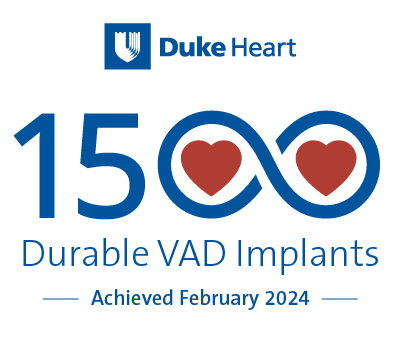
In February 2024, Duke’s ventricular assist device (VAD) program completed their 1,500th durable device implant since 1994. “Achieving 1,500 VAD implants is a testament to the unwavering dedication, clinical expertise, and commitment of each member of our multidisciplinary team and the community partners who identify patients that may benefit from this therapy,” says Carmelo A. Milano, MD, division chief of cardiovascular and thoracic surgery at Duke Health.
“As one of the first VAD centers certified by The Joint Commission, we are proud of the high standards and quality care provided to each VAD patient at Duke,” Milano adds. “Each implant represents a life impacted and a step forward in delivering comprehensive advanced heart failure care to the patients in our region.”
Leading-edge VAD research
Duke continues to advance research in the area of VADs. The ARIES HeartMate 3 Pump IDE study examined whether a daily dose of aspirin was necessary for VAD patients. “We wanted to define the safest use of anticoagulants for our patients,” says Stuart D. Russell, MD, medical director of Duke’s mechanical circulatory support program and member of the data and safety monitoring board for the ARIES study. In an equivalent trial, the study found that the group which received no aspirin had fewer bleeding events and rehospitalizations, with no increase in strokes. “Now most our VAD patients receive no aspirin,” Russell says.
A recent study saw improved outcomes for patients who had an older VAD replaced with the newer, magnetically levitated HeartMate 3 (Abbott, Abbott Park, IL). Looking forward, Duke is participating in the BiVACOR (BiVACOR Inc., Huntington Beach, CA) early feasibility study of a total artificial heart (TAH). Intended as a bridge to transplant, the new TAH uses the same magnetic levitation technology that has been proven effective in VADs through Duke research.
“Duke has been one of the highest enrollers across all of the clinical trials,” says Russell. “Our patients have helped pave the way for VADs getting better and better over time, and we continue to participate in clinical trials to help push the field forward.”
VADs as a treatment option
Although VADs were initially used primarily as a bridge to transplant, now VADs have become destination therapy for 73% of patients, who may not qualify for heart transplant because of factors including age. “Many patients in their 70s with heart failure may think there’s nothing more to be done,” Russell says. However, VADs may be indicated when patients fulfill at least some of the following:
- Recurrent hospitalizations for heart failure
- No longer tolerating heart failure medications
- Increasing doses of diuretics
- Inability to tolerate ambulation or activities due to shortness of breath
- Worsening kidney function
- Low sodium
If a patient meets two to four of those criteria, the prognosis is poor. “Fifty percent die within the year,” Russell says. “That’s when you really have to consider VADs. With the best VADs, the five-year survival rate is around 60%, and we have patients who are able to live fulfilling lives for another 10 years on VADs.”
Rising heart failure rates mean VADs remain an important treatment option, says Stephanie G. Barnes, MSN, NP, Duke’s clinical director for advanced heart failure services. “We feel strongly that this therapy should be offered to patients when transplant isn’t an option, and we’re proud to offer a second opinion to patients who may not be candidates at other centers.”
Increasing access to VADs
With shared care centers throughout multiple states, Duke coordinates with providers so patients can receive continuing care in their own communities. These shared care centers mean that more patients can receive quality care with access to VADs.
Partnering with local care facilities to find those best suited for VADs, Duke teams focus on access. “We try to meet the patient where they are and mitigate social barriers to treatment by keeping patients in their communities for the majority of their care and reducing the burden of travel,” says Barnes.
While the recent milestone is significant for the VAD program, the most important measure is the patients’ improved quality of life. “It’s been awesome to see people get chunks of their life back,” says Laura Blue, DNP, Duke’s lead VAD coordinator since 2003. “They have more time to meet their dreams. Giving people more time to spend with their families and accomplish goals has been the best part of this process.”


